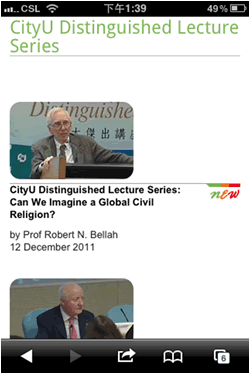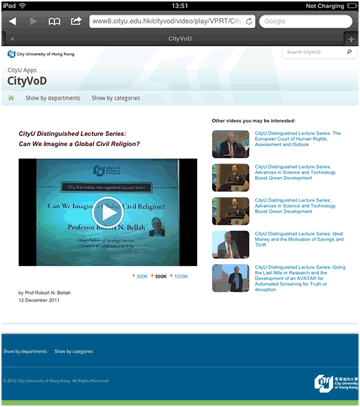Upgrading CityVoD: you can make a difference
The new CityVoD (ref: http://www6.cityu.edu.hk/cityvod/) was launched in November last year. Its interface not only changed to allow users to use mobile devices such as iPhone, iPad, Android and Windows Phone 7 to navigate and watch videos but the underlying technology of the service also enhanced to enable this support. The CityVoD is the University’s video service which allows users to select and watch videos and listen to audio recordings on the web at their own time. Apart from selecting videos from the CityVoD collection and establish direct link to videos from websites, videos can also be embedded in the CAP (CityU Announcement Portal) for making video announcement.


Background
Since 1999, the CityVoD has provided the video-on-demand service in CityU. At the infant stage, the CityVoD service was only available in some lecture theatres and computer terminal rooms. In 2004, with the technology advancements such as streaming technology and broadband networks, the service was extended to off-campus and video streaming was provided in multiple bitrates through the RealMedia Helix server.
The New Delivery Technology
At the moment, there are two video delivery methods dominating the Internet world, namely Adobe Flash and HTML5[i]. Both of them have strengths and limitations.
Adobe Flash
Strengths:
1) Over 95% of all internet-connected computers are installed with Adobe Flash Player[ii]. Almost all users are ready to watch Flash videos on their PCs.
2) Users can enjoy quality Flash videos supported by multi-resolution, multi-bitrate dynamic streaming when using the Adobe Flash Player. , The Flash media server offers a steady playback without interruption even under fluctuation of network bandwidth and limited CPU resources.
3) Better security. The Flash media server provides server-side action scripts to ensure protected videos are only accessed by authorized audiences. Moreover, via RTMP streaming, it assures the recording content will not be stored on users’ devices.
Limitation:
1) Weak support in mobile devices. iOS devices like iPhone and iPad are not supported. Adobe has announced that they would no longer update their Flash player for mobile devices last year[iii].
HTML5
Strengths:
1) All the latest browsers, such as Internet Explorer 9, FireFox 4, Safari and Chrome, support native HTML5 video playback without the need for third-party plug-ins,
2) Supported by many mobile devices, such as iPhone, iPad, Android and Windows Mobile 7.5.
Limitation:
1) Low security. Only support http streaming (progressive download) which makes it easy for users to download protected videos.
To enjoy the advantages of both delivery methods, the Computing Services Centre (CSC) chose a hybrid video streaming solution (a mix of Adobe Flash video and HTML5 video). In order to migrate from the Real Media Helix server to this solution, the following tasks were carried out:
1) Implemented the Adobe Flash Media Server to provide dynamic streaming.
2) Developed a user access control action script for protected videos.
3) Used JavaScript detection to determine which of the two methods should be used to stream the video. If the client device has a Flash player installed, dynamic streaming will be provided. Otherwise, a HTML5 video will be streamed to the user’s device, such as iPhone and Android.
4) Developed an application to handle the old video links. When the user accesses the old video link, it will be redirected to the new link.
5) Converted over 3,000 video archives from WMV, RM and MOV formats to H.264 MPEG-4 and WebM video formats. Each video was converted into various copies in different bitrates (ranging from 300K to 1500K) and resolutions for users to enjoy the best quality of video in different environments.
6) Revamped the CityVoD web site to facilitate easy navigation by mobile devices.
How to Provide Video Contents for the CityVoD?
Departments can put up videos in CityVoD by submitting a CSC Work Request declaring originality or copyright compliance and sending the sources in DVD, USB etc. (preferred formats: DVD videos, MPEG4, WMV) to the CSC General Office.